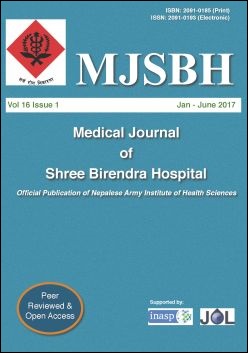Presenting complaints in Gynecology Outpatient Department (OPD) and Prevalence and Assessment of Dysmenorrhea
Keywords:
dysmenorrhea, gynecological problems, menstrual problemsAbstract
Introduction: Menstrual disorder encompasses a major chunk of gynecological outpatient department visits. Among menstrual disorders, dysmenorrhea is the commonest problem during reproductive life. Dysmenorrhea is crampy lower abdominal pain involving lower back, genitalia and upper thigh. Its prevalence varies widely from 40-94% with environment, ethnicity, lifestyle etc. It is a major cause for absenteeism from job/school. Common risk factors include family history, low body mass index (BMI), early menarche, psychological factors, smoking etc.
Methods: This non-interventional cross-sectional study was conducted over 427 females of reproductive age group (15-49 years) visiting Gynecology OPD for 6 months’ duration. Information was gathered from patients using a semi-structured standardized questionnaire formulated after a pilot study after obtaining written consent. Patients out of the specified age group, not giving consent, or previously interviewed patients coming for follow-up were excluded from the study.
Results: This study showed the commonest complaint for visiting hospital as lower abdominal pain (50.6%), followed by menstrual abnormalities and Per-Vaginal (PV) discharge. Among menstrual problems, majority complained of irregularity of cycle (53.3%), followed by menorrhagia. The lifetime prevalence of dysmenorrhea was 86.4%, while point prevalence was 75.6%. Among dysmenorrheic individuals; 36.9%, 26.8% and 36.3% had mild, moderate, and severe pain respectively. Among them only 24.6% were taking medications and 6.5% were using hot water bag. There were significant correlations of severity of dysmenorrhea with its impact on activities (p=.000) and intervention (p=.000) though there was no significant correlation with family history, alcohol and tobacco consumption.
Conclusion: Lower abdominal pain is the commonest complaint for gynecological OPD visit. Among menstrual disturbances, dysmenorrhea is a common entity that has significant impact on life and needs proper intervention.
Downloads
Downloads
Published
How to Cite
Issue
Section
License
This license enables reusers to distribute, remix, adapt, and build upon the material in any medium or format for noncommercial purposes only, and only so long as attribution is given to the creator.




